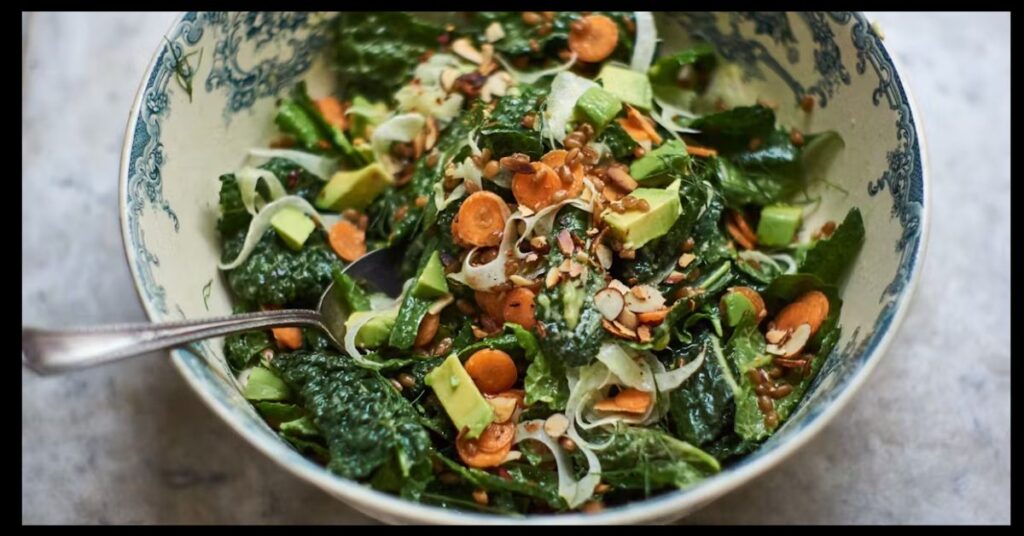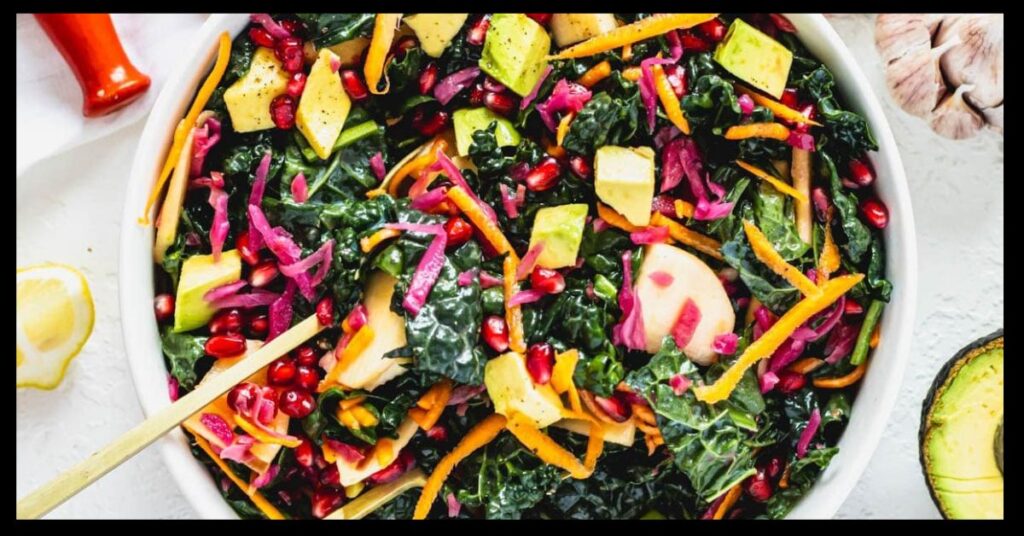Kale, often dubbed the “queen of greens,” is more than just a health trend — it’s a versatile, nutrient-packed leafy green that can be transformed into a variety of delicious meals. With the right recipes and preparation techniques, kale can go from a tough superfood to a staple in everyday cooking. This article explores the nutritional benefits of kale and presents a selection of tasty kale recipes, using a “Three Trees” approach: Raw, Cooked, and Blended — helping readers incorporate this powerhouse green into meals at every stage.
Table of Contents
ToggleWhy Kale Is a Superfood
Nutritional Profile of Kale
Kale is a cruciferous vegetable, part of the same family as broccoli, cabbage, and Brussels sprouts. According to the USDA, one cup of raw kale contains:
- Vitamin A: 206% of the Daily Value (DV)
- Vitamin C: 134% of the DV
- Vitamin K: 684% of the DV
- Calcium: 9% of the DV
- Iron: 6% of the DV
- Fiber: 2.6 grams
It’s also rich in antioxidants such as quercetin and kaempferol, which have anti-inflammatory and heart-protective properties (Source: National Institutes of Health).
Health Benefits
- Supports Heart Health: Kale contains bile acid sequestrants that may help lower cholesterol levels.
- Aids Digestion: High in fiber and water, kale supports a healthy digestive system.
- Promotes Bone Health: Vitamin K is essential for calcium absorption and bone metabolism.
- Detoxifying Effects: Sulforaphane in kale helps eliminate toxins and supports liver function.
Three Trees Approach to Kale Recipes
To make kale a part of daily meals, this guide presents three categories: Raw, Cooked, and Blended. Each approach provides unique flavor and texture experiences while retaining kale’s nutritional value.
Tree One: Raw Kale Recipes – Fresh and Crunchy
Raw kale is ideal for salads, slaws, and light sides. The key to enjoying raw kale is proper preparation, such as massaging it to soften the leaves.
1. Massaged Kale Salad with Lemon and Parmesan
Ingredients:
- 1 bunch of curly kale, stems removed and chopped
- 2 tbsp olive oil
- Juice of 1 lemon
- Salt to taste
- ¼ cup grated Parmesan cheese
- Crushed walnuts (optional)
Instructions:
- Place kale in a large bowl, drizzle with olive oil and lemon juice.
- Massage the kale for 2-3 minutes until tender.
- Sprinkle with salt, Parmesan, and walnuts.
- Toss and serve chilled.
2. Kale and Apple Slaw
Combining the slight bitterness of kale with the sweetness of apples creates a refreshing slaw.
Ingredients:
- 2 cups shredded kale
- 1 apple, thinly sliced
- ¼ red onion, finely sliced
- 2 tbsp apple cider vinegar
- 1 tbsp honey
- 1 tbsp olive oil
Instructions:
- Mix vinegar, honey, and oil to form the dressing.
- Toss kale, apples, and onion with the dressing.
- Chill before serving.

Tree Two: Cooked Kale Recipes – Warm and Hearty
Cooking kale helps mellow its bitterness and adds richness to meals.
3. Garlic Sautéed Kale
This simple side dish enhances kale’s earthy flavor with garlic and olive oil.
Ingredients:
- 1 bunch of kale, stems removed and chopped
- 2 cloves garlic, minced
- 2 tbsp olive oil
- Salt and pepper to taste
Instructions:
- Heat olive oil in a skillet over medium heat.
- Sauté garlic for 30 seconds, add kale and cook for 5–7 minutes.
- Season and serve hot.
SEO Keywords: sautéed kale recipe, cooked kale side dish, garlic kale recipe
4. Kale and Chickpea Stir-Fry
A plant-based protein-packed dish ideal for dinner.
Ingredients:
- 1 cup cooked chickpeas
- 2 cups chopped kale
- 1 bell pepper, sliced
- 1 tbsp soy sauce
- 1 tsp sesame oil
- 1 clove garlic, minced
Instructions:
- In a pan, heat sesame oil and sauté garlic.
- Add bell pepper and chickpeas, cook for 3 minutes.
- Add kale and soy sauce, cook until kale wilts.
- Serve over rice or quinoa.
Tree Three: Blended Kale Recipes – Smooth and Satisfying
Blending kale into smoothies and soups is an effortless way to add nutrients.
5. Green Kale Smoothie
Great for breakfast or a post-workout snack.
Ingredients:
- 1 cup kale leaves
- 1 banana
- ½ cup pineapple chunks
- 1 cup unsweetened almond milk
- 1 tsp chia seeds
Instructions:
- Blend all ingredients until smooth.
- Serve immediately.
6. Creamy Kale and Potato Soup
A warming dish perfect for cold days.
Ingredients:
- 2 potatoes, peeled and diced
- 2 cups chopped kale
- 1 onion, chopped
- 2 cups vegetable broth
- ½ cup coconut milk
- Salt and pepper
Instructions:
- Cook onion and potatoes in broth for 10–15 minutes.
- Add kale and cook until tender.
- Blend until creamy, then stir in coconut milk.
- Season and serve.
Tips for Cooking with Kale
- Remove Stems: Kale stems can be tough; remove them before preparing most dishes.
- Massage for Tenderness: A bit of olive oil and lemon juice makes raw kale more palatable.
- Use in Place of Spinach: Kale can be a substitute for spinach in most cooked recipes.
- Buy Fresh or Frozen: Fresh kale is ideal, but frozen kale is a time-saving alternative with similar nutrition.
Kale in the Global Kitchen
Kale isn’t just a Western health food. In Africa, kale is often stir-fried with tomatoes and onions (known as sukuma wiki in Kenya). In parts of Asia, kale is pickled or stir-fried with fermented bean paste. This global adaptability makes kale a cultural and culinary asset.
Conclusion
Kale has earned its superfood status for good reason — it’s nutrient-dense, versatile, and accessible. From raw salads to hearty soups, the Three Trees approach makes it easy to incorporate kale into any meal. By using these recipe ideas, home cooks can enjoy the health benefits of kale without sacrificing flavor.







